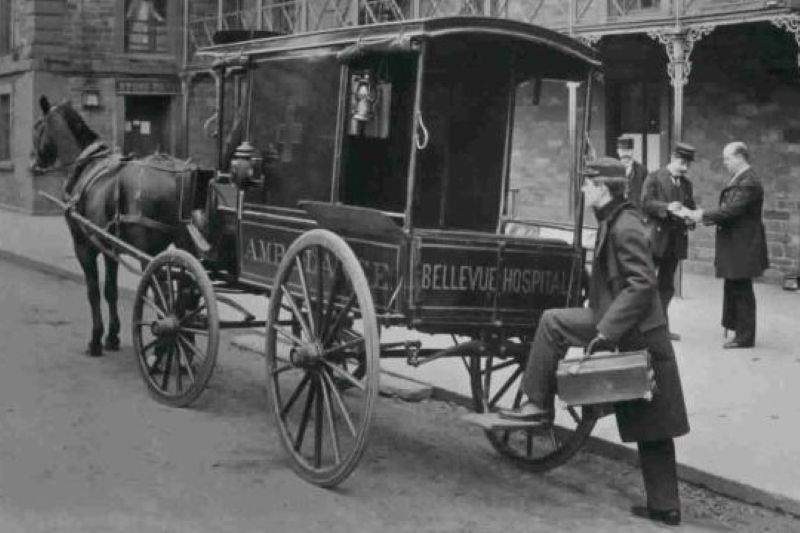
March 28, 1865 (?), the first hospital ambulance service in the USA in Cincinnati
The ambulance in the USA was not exactly born on March 28, 1865, but this is certainly a fundamental date in the history of American rescue: in Cincinnati, in fact, the Commercial Hospital begins its hospital transport service
THE RADIO FOR RESCUERS IN THE WORLD? VISIT THE EMS RADIO BOOTH AT THE EMERGENCY EXPO
Cincinnati, March 28, 1865 (?): The story of the USA ambulance begins
The need for ambulance transport is, unfortunately, one might say, historically connected to bloody events such as war.
And this also happened in the USA: the violence of the civil war made us understand the importance of emergency vehicles.
Cincinnati was soon followed by New York: in 1869 Edward Dalton, a former surgeon in the Union army, began a similar service at Bellevue Hospital.
Ambulances back then carried medical equipment, such as splints, a stomach pump, morphine and brandy (yes, you read that right).
According to Barkley, the hospital’s employment records listed employee No. 27, James R. Jackson, as an ambulance driver for $360 a year,” reports the Enquirer.
“Williams’ 1866 Cincinnati Directory verifies that James A. Jackson worked as a ‘teamster,’ or chauffeur, for the Commercial Hospital.”
The actual date on which the first ambulance entered service is a source of some debate.
Jackson was employed at the Commercial Hospital as early as 1865.
But several sources, including the National Park Service’s Shiloh National Military Park, cite March 28, 1866 as the date the first ambulance entered service.
What is not in dispute is that the human carnage left behind on Civil War battlefields like Shiloh, and the advances in medicine and trauma response that resulted from them, had a direct impact on the evolution of ambulance services that many people take for granted today.
“In August 1862, Jonathan Letterman, the medical director of the Army of the Potomac, created a highly organized system of trained ambulances and stretcher bearers designed to evacuate the wounded as quickly as possible,” reports the National Museum of Civil War Medicine.
“A similar plan was adopted by the Confederate Army. This system was a vast improvement over previous methods.”
Letterman’s system and other evolutions during the Civil War led to a tiered care system.
It started with immediate triage – separating soldiers with surviving wounds from those likely to die – then field dressing stations and field hospitals, and finally transporting the wounded to major hospitals in big cities.
The system born on the battlefield led to profound changes in national medical care after the war.
“Hospitals have become places of healing rather than places to go to die, as they were widely regarded before the war,” according to the National Museum of Civil War Medicine.
1487, Ancient Ambulances and wars
The history of the ambulance begins in ancient times, with the use of trolleys for the transport of patients.
That of the stretcher even to the wars of the ancient Romans.
As mentioned, the link between war events and the evolution of rescue is strong.
And, if we want, also of the rescuer, if we consider the impact of the Battle of Solferino (Italy), in the birth of the Red Cross.
Ambulances were first used for emergency transport in 1487 by Spanish forces during the siege of Málaga by the Catholic Monarchs against the Emirate of Granada and civilian variants were put into operation in the 1830s.
Technological advances throughout the 19th and 20th centuries led to modern self-powered ambulances.
THE BEST STRETCHER ON THE MARKET? THEY ARE IN EMERGENCY EXPO: VISIT THE SPENCER STAND
Ambulance services soon expanded from Cincinnati to other US cities
Civil War veteran Dr. Edward B. Dalton made remarkable advances in ambulance services at Bellevue Hospital in New York City after returning to civilian life.
“In June 1869, two 800-pound light trucks rolled through the streets of New York City, driven by a driver and an ‘ambulance surgeon,’ an intern fresh out of two years of medical school,” wrote the Shiloh National Military Park in a lengthy social media post about the history of ambulance care.
“Although Cincinnati had the first civilian ambulance in the United States, New York City had the first modern ambulance equipped with a sliding table, surgical light, pillows and blankets.
Medical supplies included bandages, tourniquets, a stomach pump, as well as a straitjacket, handcuffs, a flask of brandy and drugs such as amyl nitrate and morphine.
The institution added: “The war, as often happens, has brought about improvements in civilian life.”
Bellevue Hospital fielded two ambulances in 1869, which responded to more than 1,400 calls for help, according to the Journal of Emergency Medical Services.
Spurred by that public need, the hospital added five more ambulances in 1870.
Today, according to industry sources, more than 70,000 emergency vehicles respond to approximately 37 million calls nationwide each year.
Read Also
Emergency Live Even More…Live: Download The New Free App Of Your Newspaper For IOS And Android
USA, History Of The EMS System
Rescue In The World: What Is The Difference Between An EMT And A Paramedic?
Ambulance Color Codings: For Function Or For Fashion?
Travel And Rescue, USA: Urgent Care Vs. Emergency Room, What Is The Difference?
Ohio (USA), Braun Ambulances Celebrates 50 Years In Business
EMT, Which Roles And Functions In Palestine? What Salary?
EMTs In The UK: What Does Their Work Consist Of?
Cuts And Wounds: When To Call An Ambulance Or Go To The Emergency Room?
How Is Triage Carried Out In The Emergency Department? The START And CESIRA Methods
Code Black In The Emergency Room: What Does It Mean In Different Countries Of The World?
What To Expect In The Emergency Room (ER)


